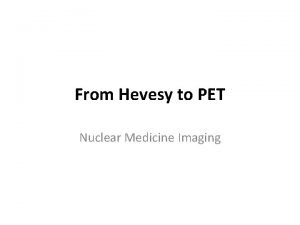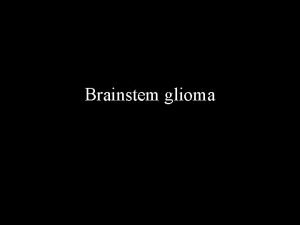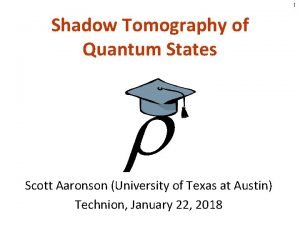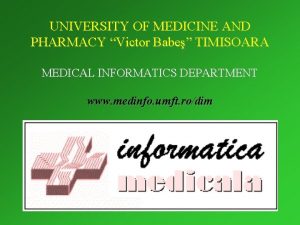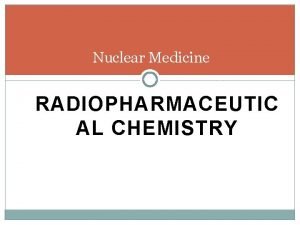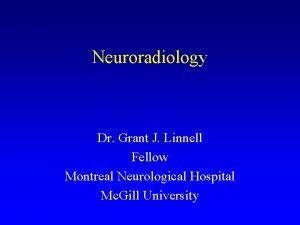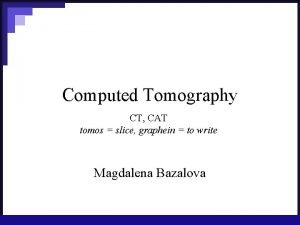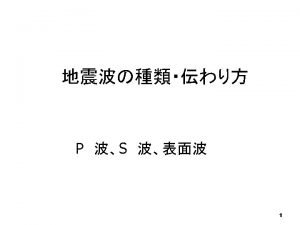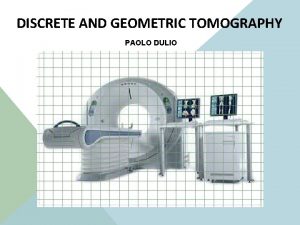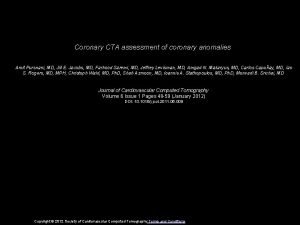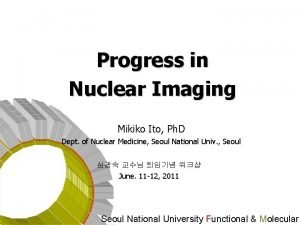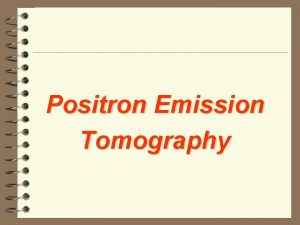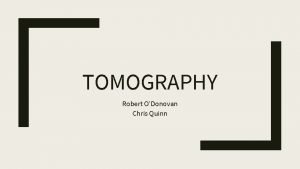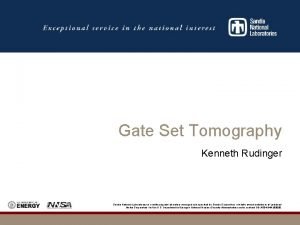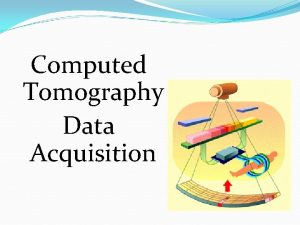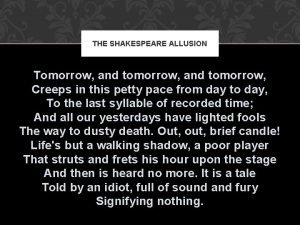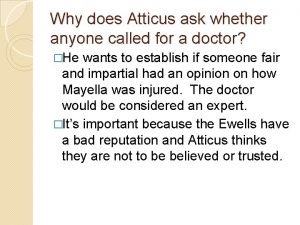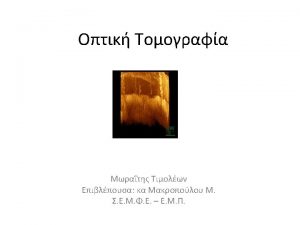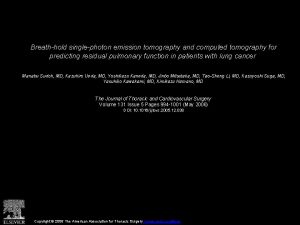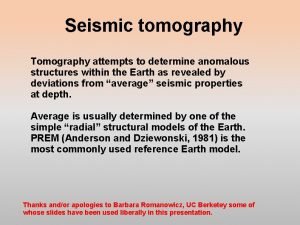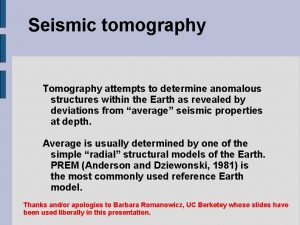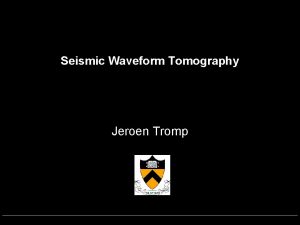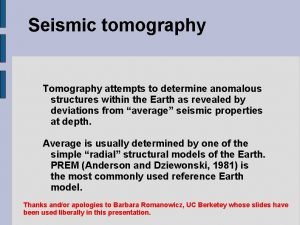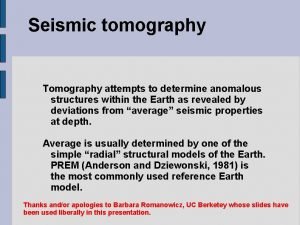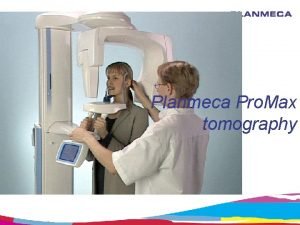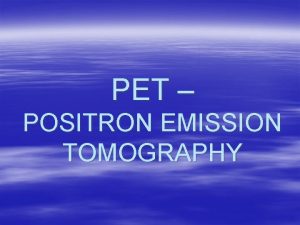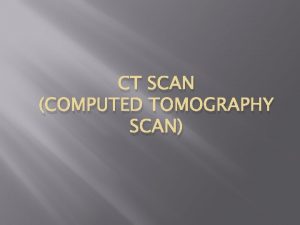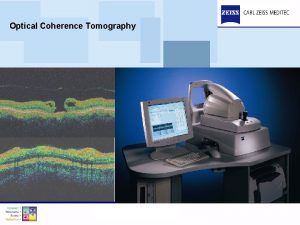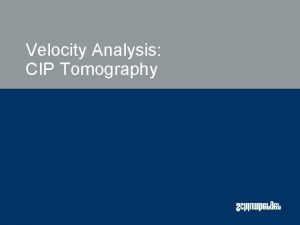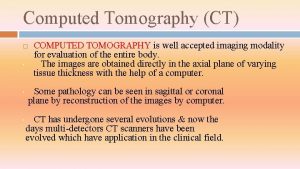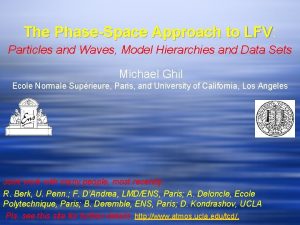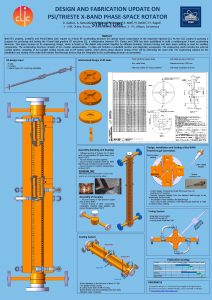PhaseSpace Tomography What is it and how does




















- Slides: 20

Phase-Space Tomography: What is it and how does it relate to Computed Tomography in Medicine? . . . and how will it be useful for EMMA? 16/09/2021 University of Liverpool 1

Computed Tomography (CT) Tomography = ‘slice writing’ (Greek) CT Scanning (Hounsfield, 1972) Reconstruction Principle: Create a ‘slice’ by digitally processing a sequence of projection images taken at angles 0° < q < 180° 16/09/2021 University of Liverpool 2

Principles of Reconstruction - from Parallel Projections Radon Transform: ∞ ∞ Pq(r) = ∫-∞∫-∞ f(x, y) d(x cosq + y sinq - r) dx dy for 0° < q < 180° Objective is to recover f(x, y) Original Image Projection Set (Sinogram) Reconstructed Slice position r angle q measured 16/09/2021 University of Liverpool calculated 3

Algorithms (1) Filtered Back Projection (FBP) For each of the K angles q, between 0° and 180° 1. Measure the projection, Pq(t) 2. Fourier transform it to find Sq(w) 3. Multiply it by the weighting function 2 p |w|/K 4. Sum, over the image plane, the inverse Fourier transforms of the filtered projections (the backprojection process) (Kak & Slaney, 1988) 16/09/2021 University of Liverpool 4

Algorithms (1) Filtered Back Projection - Schematic FFT graph Original Image Sum Back-Projections Set of Projections Fourier Back-Projection Domain Apply Filter Inverse Fourie r Reconstruction 16/09/2021 Spatial Domain University of Liverpool 5

Algorithms (1) Filtered Back Projection - Results Effect of Number of Projections 2 8 180 Effect of Irregular Intervals (20 Projections) Regular: 20 at 9° 16/09/2021 10 at 9° 10 at 4. 5° University of Liverpool 10 at 9° 10 at 4. 5° (weighted) 9

Algorithms (2) Iterative Methods Examples (used for Phase-Space Tomography): § MENT: § MLEM: Maximum Entropy Tomography Maximum Likelihood Estimation Maximisation Comparisons with Filtered Back Projection (FBP): • Computationally intensive, can be very slow • Better results for sparse data (few projections), or unequal angular intervals in q • Less sensitive to noise 16/09/2021 University of Liverpool 10

Algorithms (2) Iterative Methods A typical algorithm (MLEM): 1. Start with an initial “estimate” of the source distribution (e. g. uniform) 2. Forward-project this estimate along measured projections to work out what we should have measured if the estimate is correct. 3. Compare this to what we actually did measure. 4. Update the estimate based on the comparison. 5. Continue until some convergence criteria is met. 16/09/2021 University of Liverpool (Mather, 2005) 11

Tomography in Phase-Space - What is it useful for? • Complementary to other diagnostic tools, and for comparison with simulations • Estimate emittance e , but with no need to assume elliptical distribution in (x, x’) • Investigate ‘unusual’ features of phase-space; can show details otherwise unavailable 16/09/2021 University of Liverpool 12

Relating Phase-Space to Real-Space Tomography: 3 Key Parameters In phase space: • Consider beamline elements equivalent to simple linear transformations on the (x, x’) distribution • Examples: quadrupoles (focussing/defocussing), drift spaces, … Represent in general by matrices of the form x 2 ’ 16/09/2021 = MTransfer* x 1 ’ where MTransfer = University of Liverpool R 11 R 21 R 12 R 22 13

1 - Rotation Angle Simple Example: Drift Space of length L represented by matrix MDrift = 1 0 L 1 Relate this type of transformation to an effective tomographic rotation q by tan q = 16/09/2021 R 12 University of Liverpool 14

2 - Projection Scaling Factor This relates the projection of phase-space distribution f 2(x, x’) after transformation, to the projection of the original distribution f 1(x, x’) r The value of s may be derived trigonometrically as follows: - r x 2 * sin q R 12 where s is defined as = 16/09/2021 r or s = R 12 sin q = x 2 s = √(R 211 + R 212), University of Liverpool using the relation for tan q 15

3 - Population Distribution Equivalence y 2 Real Space Phase Space x 2 dx measured projection required projection Projection of phase-space (required): f(r, q) = s * A(x 2) alternative views of same particles in small interval [x, x+dx] where A(x 2) is the measured projection in real (x, y) space, and s is the Scale Factor s = √(R 211 + R 212) 16/09/2021 University of Liverpool 17

Summary of Steps Required to Implement the Method Acquire beam profiles at set positions and/or Quad settings Feed into appropriate Reconstruction algorithm Measure projections onto x (or y) axis Calculate Angle q, Scale-Factor s for each projection Phase-Space Reconstruction 16/09/2021 University of Liverpool 19

Limitations of the Method • Space-Charge Effects – must be considered, in high bunch-charge regime • Non-Linearities in Optics – affect calculation of Phase-Advance, x-y coupling • Both of these can apply to EMMA – Space-Charge already modelled for Injection Line Tomography (D Holder) Ø 16/09/2021 Validation essential - by Simulation University of Liverpool 20

Practical Considerations • Image Capture Hardware – Phosphors/OTR screens/Wire Scanners – Select to suit particles/energy/beam dimensions – Quality (noise), alignment, magnification • Phase Rotation Methods – Fixed advances/scanning • Reconstruction Algorithm – MENT vs FBP, depends on situation 16/09/2021 University of Liverpool 21

Location Application of Phase-Space Tomography - A Brief Survey Accelerator Type Date Method Algorithm Los Alamos (Mottershead) FMIT 1985 Residual Gas Interaction MENT Duke Univ. (Mc. Kee) Mk III Linac (for FEL) 1995 Quad scans, screens FBP Brookhaven (Yakimenko) ATF - Laser Photocathode 2003 9 Quads, Phosphors FBP DESY (Scheins) TESLA Test Facility 2004 Wirescanners, OTR, &c. MENT PSI (Rohrer) Proton Lines (780 ke. V 590 Me. V) 1982 2007 1 screen, vary optics MENT Maryland (Stratakis) UMER 2006 Quad scanning FBP Cornell (Hannon) 16/09/2021 ERL Gun 2008 Solenoid scans, screens MLEM University of Liverpool 22

Summary • Phase-Space Tomography (PST) is an established diagnostic tool useful in a variety of particle beam situations • PST may be applied even without specialised facilities • For EMMA, a dedicated PST capability is built into the Injection and Extraction lines 16/09/2021 University of Liverpool 23

Phase-Space Tomography for EMMA – Status (Jan 2010) • Simulation – MATLAB Beam Transport code and Quad setting calculations in progress • Reconstruction – In-house Codes in MATLAB for FBP and MENT implemented, and others are available as backup • Injection Beam-Line – Fitting/cabling with basic cameras in progress; specialist camera requirements under consideration 16/09/2021 University of Liverpool 24

Acknowledgements • Dr K Hock – For advice on methods, and Implementations of Reconstruction algorithms • Dr A Mather (Liverpool) – For material on Iterative codes, and a personal version of the FBP algorithm • D Holder – For sharing his experience of planning the EMMA Injection Line for matching the tomography section 16/09/2021 University of Liverpool 25
 Researchgate
Researchgate Chodorma
Chodorma Shadow tomography
Shadow tomography Seismic tomography ______.
Seismic tomography ______. Computed tomography timisoara
Computed tomography timisoara Positron emission tomography
Positron emission tomography Positron emission tomography
Positron emission tomography Hematome
Hematome Computed tomography artifacts
Computed tomography artifacts Seismic tomography
Seismic tomography Tomography
Tomography Amit pursnani
Amit pursnani Positron emission tomography
Positron emission tomography Positron emission tomography
Positron emission tomography What is tomography
What is tomography Kenneth rudinger
Kenneth rudinger Ct data acquisition system
Ct data acquisition system He never washes up song
He never washes up song William shakespeare tomorrow and tomorrow and tomorrow
William shakespeare tomorrow and tomorrow and tomorrow Why does mayella think atticus is mocking her?
Why does mayella think atticus is mocking her? What spooked jem on the night of the radley
What spooked jem on the night of the radley
